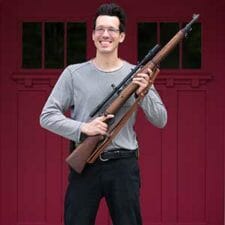U.S.A. -(AmmoLand.com)- Bullpup rifles have been around since the early 20th century, but the first mainstream design didn’t arrive until the late 1970s with the Steyr AUG. Since then, the AUG and the French FAMAS have shaped the public perception of bullpups despite a much wider variety of designs on the market. Most new designs have been unavailable in the US due to the 1989 restrictions on imports. So Americans don’t have access to most foreign designs like those from China, Croatia, and Singapore. On the plus side, the US has several high-quality, domestically-produced bullpups that deserve a serious look.
Bullpup Background, Benefits and Drawbacks
The concept of moving the action behind the controls isn’t new. Firearm designers have been doing so since the early 1900s. But the concept wouldn’t really gain traction until optics overtook iron sights as the primary aiming devices for militaries. This is because the reduction of sight radius made the weapons much less accurate and more difficult to precisely aim. With the addition of optics, the bullpup rifle had nearly every benefit of a traditional firearm but with a reduction in overall length. Another one of the complaints about early bullpups was the spongy trigger resulting from the use of an internal transfer bar for the trigger. This has since been fixed by many designers in a variety of ways. One way Keltec accomplishes this is by moving the sear under the pistol grip and lengthening the hammer struts. This in effect reduces the overall length of the transfer bar which in turn reduces the amount of bow in it and friction, resulting in a smoother, crisper trigger.
Another issue was how unfriendly the gun’s ejection is to left-handed shooters. Because the ejection port is adjacent to the shooter’s face, left-handed shooters often were pelted with hot brass, making accurate shooting understandably difficult. This has since been resolved on several models through forward-ejection of shells like on Maxim machine guns. Notable examples of rifles using forward ejection include FN’s FS2000 and Keltec’s RFB.
An alternative solution is bottom-ejection. Similar to a Vickers and Browning machine gun from the First World War, this method is employed on some modern firearms like the FN P90 and Keltec RDB. A third option is an interchangeable ejection port like those found on the IWI X95 and the Desert Tech MDR Interestingly, Singapore offers a bullpup that can switch not only left and right ejection, but also forward with their BR18. Sadly, this rifle is unavailable in the United States.
Another old complaint about bullpups mentions the slower speed of reloads. But that turned out to be as much as an issue of technique as of substance on those rifles that drop the magazines free. On weapons like the Tavor SAR and Keltec RDB where mags don’t drop free, reloads are still quicker than some traditional designs like the AKM thanks to bolt hold-open feature on the last shot. One complaint that I don’t hear much that is actually relevant is the increased heat retention of the rifle’s barrel. This is due to the barrel being largely encased in the receiver of the bullpup, and thus lacking airflow. Fortunately, that’s more of an issue for military use than it is for personal defense or a hunting semi-auto. Lastly, most bullpups have a fixed length of pull. Meaning soldiers and civilians who aren’t comfortable with their bullpup’s length are out of luck.
The only exception available now is Keltec’s RDB-S.
The advantages of bullpups are quite significant. Besides the obvious increase in the barrel length, bullpups are usually neutrally balanced towards the center, permitting effective control with one hand if necessary. They feel lighter for the same actual weight and are easier to hold on target unsupported. It’s possible to add a hefty sound suppressor without getting the feeling of a cinderblock tied to a stick that happens with conventional rifles. Unique to bullpups is the importance of noise reduction with suppressors and redirection of muzzle blast with linear compensators. This is because of the closer proximity of the muzzle to the shooter’s ears and face.
That said, the bullpup rifle market is very crowded, so which one should a shooter choose? Let’s look at the options available to the US shooter.
Steyr AUG
The current A3M1 variant of the 5.56mm caliber Steyr AUG is a far cry from the original 1978 model. It features removable magnified optic which can accommodate a Picatinny rail, and features more mounting options on the sides of the weapon. The AUG still benefits from great balance and reliability as well as making an excellent suppressor host. Plus, the gun still retains the original quick-change barrel system making it easy to transport and store. Unfortunately, it still includes the original spongy trigger and exposed gas regulator that can burn the support hand if the user isn’t careful. And while ejection can be switched from right to left, it requires tools and a special left-handed bolt.
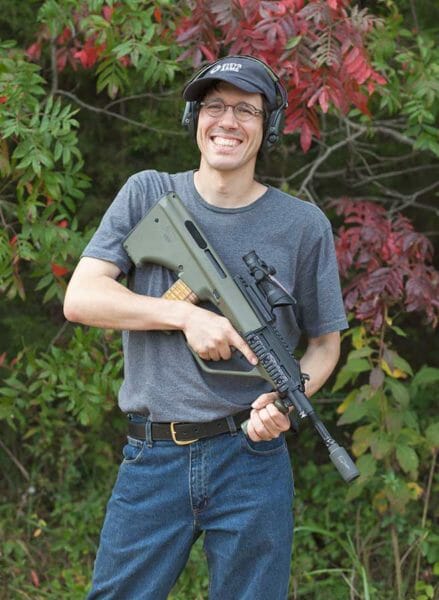
FN FS2000
The recently-discontinued 5.56mm FN FS2000 had a good run of about eighteen years. “The whale” of a rifle, it looked bulbous, sported a typical spongy trigger and somewhat slow reloads thanks to the lack of last shot hold-open and the mag well gasketing. The FS2000 did feature forward ejection and a cleverly designed cowling for quickly checking the chamber despite the lack of a conventional ejection port. It is a very comfortable, low-recoil shooter. Originally, the FS2000 was meant as a highly modular military weapon, but very few of the components were available to the US shooters.
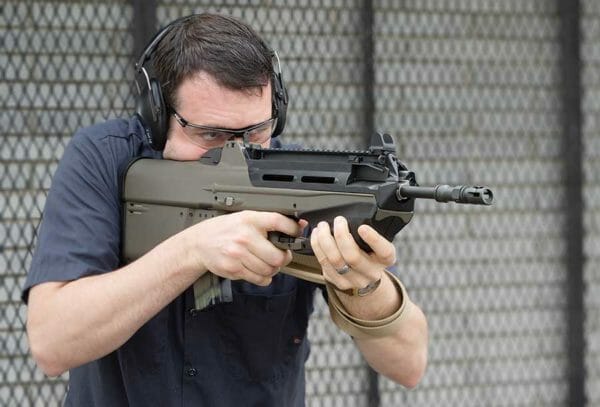
FN PS90
The FN PS90 is the civilian variant of the FN P90 submachine gun. Restricted to semi-automatic operation only, the addition of a 16in NFA-compliant barrel doesn’t ruin its compact size. The PS90 still uses the iconic 50-round top-mounted translucent polymer magazines. And despite its use of a short recoil moving barrel, the design is remarkably compact. Other notable features include ambi-friendly bottom-ejection, incredibly low felt recoil and it uses a remarkably flat-shooting pistol round, the 5.7x28mm cartridge. Unfortunately, like FN’s other bullpup, the trigger pull isn’t great by any means. Plus the odd ergonomics force shooters to place their support hand directly inside the trigger guard. Also, the integrated unmagnified optic is quite poor, but the tri-rail variant allows the use of other sights.
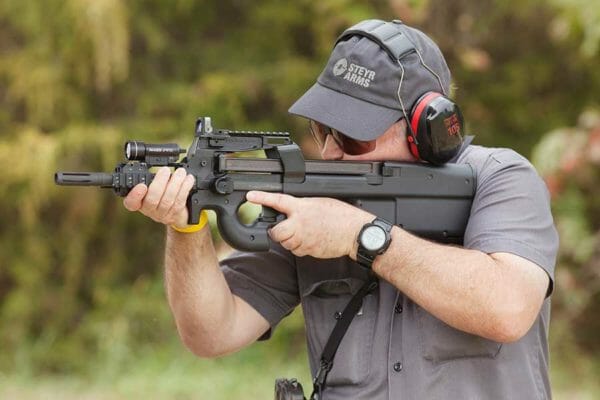
IWI Tavor
IWI Tavor SAR and X95 are adaptations of the 5.56mm Israeli IDF weapons. Robust and reliable, they are fairly heavy. Both variants come with a heavy, long trigger: fortunately, drop-in replacement trigger packs can be installed in seconds. Pop-up backup sights are adjustable and the front post is illuminated with tritium. The SAR uses a lever mag catch that promotes retention of empty magazines, while X95 has a button release optimized for speed. Both models are suppressor-friendly despite the fixed gas system. X95 is generally more modular and slightly more durable. The X95 benefits from aftermarket free-float rails and left-hand ejection is possible. But like the AUG above, it requires a dedicated bolt and a complete tear-down of the rifle.
All the abovementioned rifles other than the Tavor have integrated entirely non-adjustable backup sights meant for emergencies. All make extensive use of plastics in the mechanism and the body of the gun. These rifles started as military designs and were made into civilian semi-autos later. Most of the American-designed bullpups, by contrast, were designed for non-military use from the start.
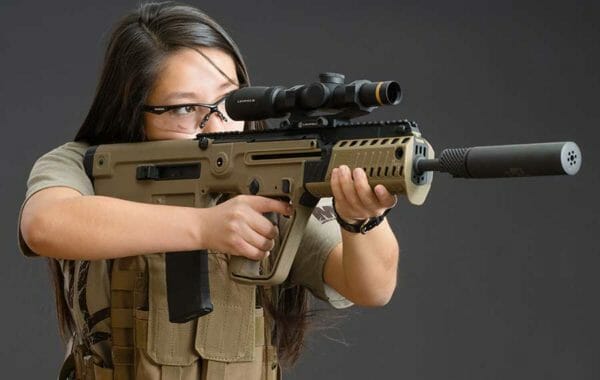
Keltec RFB
One very unique example of bullpup rifle is the Keltec RFB. Unlike most firearms, The RFB anchors the rest of the firearm’s components to a heavy barrel acting as a spine. Designed back when FAL magazines were among the few available at a reasonable price, it not only uses FAL magazines, but also FAL-style tilting bolt lockup. The RFB features a forward-ejection port which is great for left-handed shooters but makes administrative chamber checks slow. Since this requires removing the magazine to check the chamber. Despite lacking a free-floated barrel, both the 18-inch carbine and the 24-inch barreled target RFB models are quite accurate. Other benefits of the design include an excellent trigger and adjustable gas system that allows the RFB to run well even suppressed.
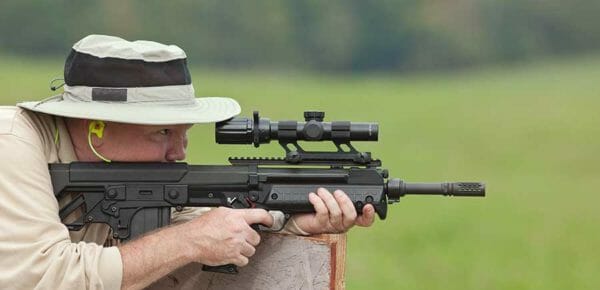
Keltec RDB
Unlike its big-bore brother, the 5.56mm Keltec RDB is a much simpler design. It uses a rotating bolt and bottom ejection behind the magazine, making it both reliable and ambi-friendly. The design borrows elements from both the Ultimax 100 and AKM. Available in a wide variety of barrel lengths and weights, the RDB is modular, lightweight and accurate. And thanks to the significant bolt overtravel past the back of the magazine, felt recoil is minimized and feeding is quite energetic.
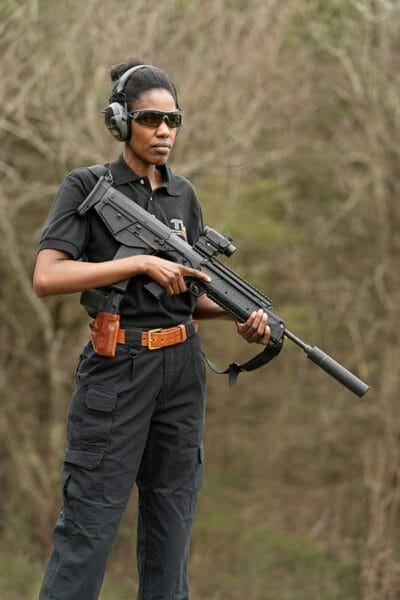
Desert Tech MDR
A less budget-friendly bullpup is the Desert Tech MDR. Chambered in either 5.56mm or 7.62x51mm, its ejection can be swapped from right to left in the field, and an ejection chute redirects spent casings forward. The system works well, though with significant mechanical noise. The rifle boasts a very good trigger and high accuracy. Felt recoil, especially in 7.62mm chambering, is on the brisk side. The adjustable gas system makes it suppressor-friendly.

K&M M17S
The M-17S is available in 5.56mm, 300B Blackout, and 7.62mm models. Based broadly on the discontinued Bushmaster M17, the 17S greatly improves on the original in ergonomics. The entire mechanism and the barrel are contained within a long aluminum extrusion. Thanks to aggressive skeletonizing, the rifle cools well. It’s accurate, has a good trigger and low recoil. Right-side ejection only.
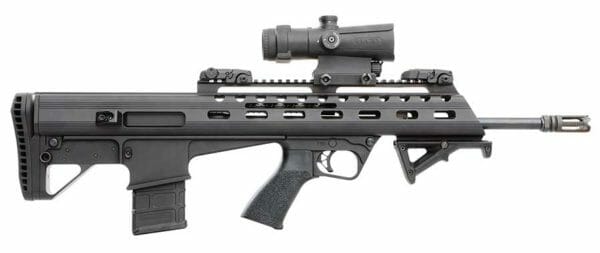
Barrett M99/M95
Barrett M99 and M95 are the single-shot and magazine-fed variants of the same bolt action. Relatively lightweight for the caliber and simple in design, they deliver incredible power and accuracy. Both have somewhat brisk recoil, but that’s to be expected from any .50 BMG firearm. Muzzle brake and (optional) sound suppressors reduce the recoil somewhat. Compared to their semiauto counterparts, these bolt actions are less expensive, 30 percent lighter, and better balanced for unsupported use.

Desert Tech SRS/HTI
Desert Tech’s SRS and HTI are the regular and anti-materiel variants of the same bolt action concept. SRS is chambered in a variety of antipersonnel calibers like 6.5 Creedmoor and 308Win, while HTI chambers 50BMG, 408 Cheytac and they like. Both designs are modular. However, the SRS, in particular, can be made into a compact Covert configuration. Swapping calibers is a breeze, but ejection is right side only. With manual actions, that may be less of an issue, but the bolt handles also intrude on the space occupied by the shooter’s face. Great triggers and sub-MOA accuracy make these very popular with precision shooters. Interestingly, Desert Tech bolt actions use construction methods similar to Keltec, with a steel receiver inside plastic panels held together with screws. The results obtainable with the platform speak for themselves.
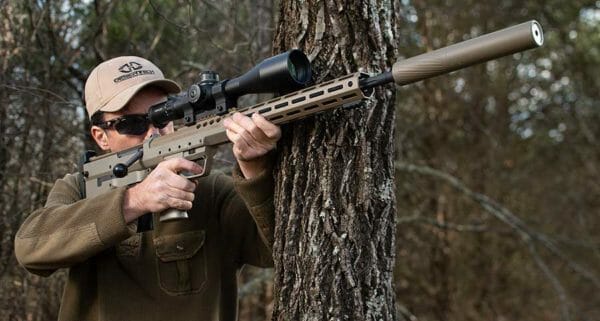
Bullpups have come a long way from the kludgey Mini14 and AK conversions. About a third of the world’s militaries, including China, issue bullpup rifles as standard. In the US, excellent choices are available for almost every taste in ergonomics, action type, and caliber. In my experience of training people, bullpups work particularly well for shooters with limited upper body strength by bringing the center of mass close to the body. They aren’t ideal for every situation, but with their myriad of benefits, it’s no wonder they’re gaining in popularity around the globe.
Oleg Volk is a creative director working mainly in firearms advertising. A great fan of America and the right to bear arms, he uses his photography to support the right of every individual to self-determination and independence. To that end, he is also a big fan of firearms. Check out his world-renowned photography and his YouTube channel.

